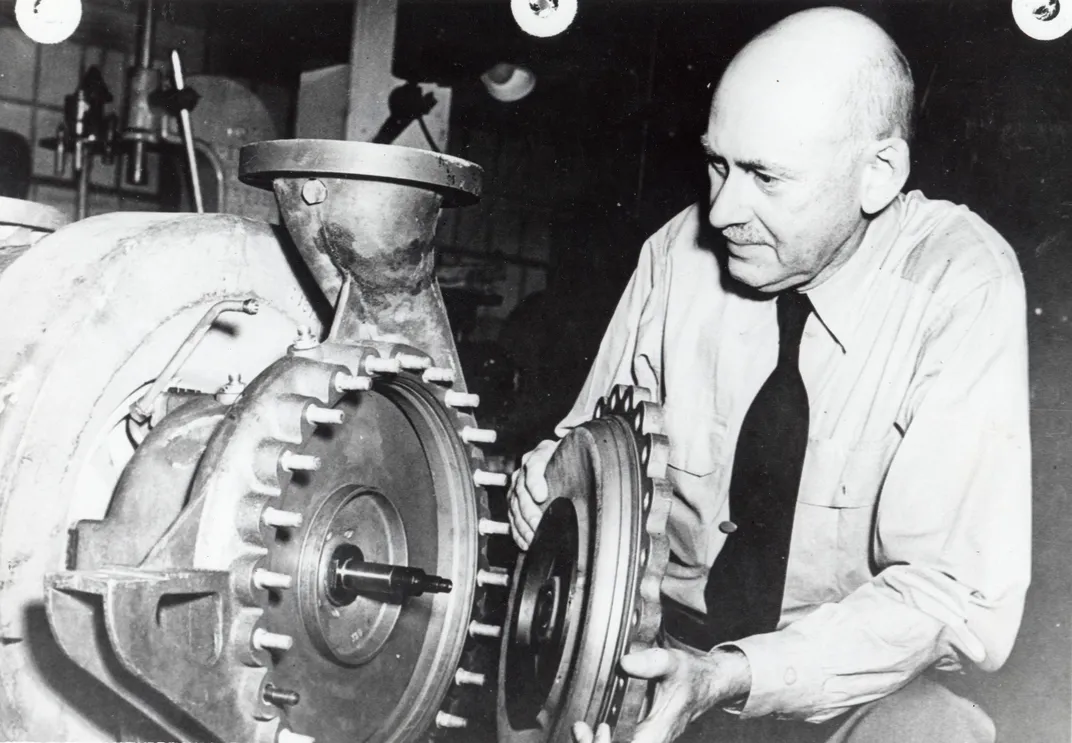Robert Goddard Was the Father of American Rocketry. But Did He Have Much Impact?
Questioning a pioneer’s legacy.
/https://tf-cmsv2-smithsonianmag-media.s3.amazonaws.com/filer/1d/8b/1d8b6277-a197-4642-bc94-06703eee1e8b/goddard_gpn-2000-001336.jpg)
Americans are justifiably proud of Robert H. Goddard, the Massachusetts professor who built and flew the world’s first liquid-fuel rocket in 1926. Goddard spent his entire life perfecting the invention he knew could one day be made to fly into space and even reach the Moon. Although he didn’t live long enough to see that dream come true (he died in 1945), German development of the liquid-fueled V-2 rocket during World War II—using the same principles—led directly to the giant Saturn V that launched NASA’s Apollo astronauts. Chronologically, anyway, Goddard can be said to have led the way to spaceflight.
But after examining this premise closely over the past few years in the course of doing research for a book on Goddard's technical accomplishments, I’ve come to a different conclusion. Because Goddard was an exceptionally secretive man, his work had less of an impact than a timeline of milestones in rocketry would suggest.
How secretive was he? Not only did Goddard make his handyman helpers sign oaths that they would never, on risk of being fired, reveal details of the work they did for him, he kept the facts of his first liquid-fuel flight from the public for a full decade. It was only in his second rocket publication, “Liquid-Propellant Rocket Development,” published by the Smithsonian in 1936, that he mentioned this flight. His first publication in 1919, “A Method of Reaching Extreme Altitudes,” dealt only with solid-fuel rockets, although he did dare to include the description of a hypothetical, unmanned, multi-stage rocket that might be able to go to the Moon. The worldwide publicity surrounding this idea, with many critics poking fun at Goddard and calling him the “Moon professor,” only made him more guarded in his work. (Russian scientist Konstantin Tsiolkovsky had written about the possibilities of spaceflight earlier, in 1903, but due to language and other problems, his ideas were not known in the West until the mid-1920s.)
In the same year “Liquid-Propellant Rocket Development” was published (which, incidentally, provided no engineering details), the German army’s sprawling rocket research center at Peenemünde opened. Under the technical direction of a young Wernher von Braun, the center went on to develop what later became known as the V-2 missile, but originally was designated the A-4. That weapon first saw action in September 1944, primarily against London. The following March, a few months before he died, Goddard was able to examine captured V-2 parts. From then on, he strongly suggested that the Germans had stolen his ideas.

Careful study of the V-2 shows, however, that the German and American rockets could not have been more different. Goddard’s largest rocket was meant only to travel vertically into the upper atmosphere, and was built to be as light as possible. The V-2 was designed for horizontal flight over long distances, and was meant to deliver its ton of explosives as a super weapon. Unlike Goddard’s small projects, the creation of the V-2 required hundreds if not thousands of scientists, engineers, and technicians, representing all kinds of disciplines, from aerodynamics to materials science and thermodynamics. The creators of the V-2 also worked in utmost secrecy. And at no point did they need to copy anything from Goddard.
In fact, the German army project had started in 1929, first with solid-fuel rockets, then, by 1931, with potentially far more powerful—and controllable—liquid-fuel rockets. By the time the Smithsonian published Goddard’s monograph in 1936, the Germans already had attained a great deal of experience with liquid-fuel rockets. Two years earlier, the experimental A-2 had already eclipsed Goddard’s inventions in terms of both thrust and altitude. The A-2 had a thrust of about 600 pounds and was able to reach 2.3 miles altitude on its second flight in 1936. As of 1934, Goddard’s highest flight (four years earlier) had reached just 2,000 feet.
We now know that Goddard’s 1930s rockets—as remarkable as they were for being built by one man with a few helpers—were no match for the German army’s accomplishments. His highest thrust ever was 985 pounds, reached in January 1941, while his highest altitude was some 9,000 ft (up to 1.7 miles) set in March 1937. By 1941, the German A-5 (an interim model for testing aerodynamics, guidance and other technology for the A-4), had a thrust of 3,305 pounds and reached 7.5 miles altitude. The A-4 (V-2) itself was powered by an engine that produced about 55,000 pounds of thrust, and had a range of 200 to 225 miles.
Aside from these impressive numbers, the A-4’s mission was quite different from that of Goddard’s rockets. Its complex, three-axis gyro guidance system was designed to steer the missile toward its long-range target, whereas in Goddard’s rockets, the gyro system was built strictly to stabilize the rocket during vertical research flights.
Finally, it’s now clear that Goddard and the German team both worked in Top Secret, completely independent of each other. So it’s more than a stretch to say that Goddard’s work led to the NASA Moon landings. After the war, U.S. rocket technology evolved from Germany’s work on the V-2, not from the New England professor’s experiments. As brilliant as Goddard’s achievements were, his rocketry had no real impact, during the war or afterward, on his field. His greatest influence may have been in helping introduce to the public the idea of the “space rocket” more than two decades earlier.